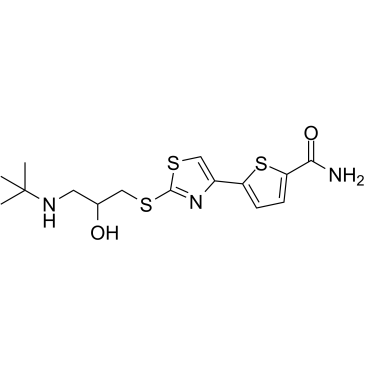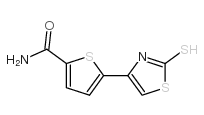5-(2-((3-(tert-Butylamino)-2-hydroxypropyl)thio)thiazol-4-yl)thiophene-2-carboxamide
Modify Date: 2024-01-03 12:25:33

5-(2-((3-(tert-Butylamino)-2-hydroxypropyl)thio)thiazol-4-yl)thiophene-2-carboxamide structure
|
Common Name | 5-(2-((3-(tert-Butylamino)-2-hydroxypropyl)thio)thiazol-4-yl)thiophene-2-carboxamide | ||
|---|---|---|---|---|
| CAS Number | 68377-92-4 | Molecular Weight | 371.541 | |
| Density | 1.4±0.1 g/cm3 | Boiling Point | 599.8±60.0 °C at 760 mmHg | |
| Molecular Formula | C15H21N3O2S3 | Melting Point | 148-149ºC | |
| MSDS | N/A | Flash Point | 316.6±32.9 °C | |
| Purity | Quantity | Budget | Inquiry |
|---|
Use of 5-(2-((3-(tert-Butylamino)-2-hydroxypropyl)thio)thiazol-4-yl)thiophene-2-carboxamideArotinolol is a nonselective α/β-adrenergic receptor blocker and a vasodilating β-blocker. Arotinolol is an antihypertensive agent for the treatment of a variety of cardiovascular pathologies as well as non-cardiovascular diseases[1]. |
| Name | 5-[2-[3-(tert-butylamino)-2-hydroxypropyl]sulfanyl-1,3-thiazol-4-yl]thiophene-2-carboxamide |
|---|---|
| Synonym | More Synonyms |
| Description | Arotinolol is a nonselective α/β-adrenergic receptor blocker and a vasodilating β-blocker. Arotinolol is an antihypertensive agent for the treatment of a variety of cardiovascular pathologies as well as non-cardiovascular diseases[1]. |
|---|---|
| Related Catalog | |
| Target |
IC50: α/β-adrenergic receptor |
| In Vivo | Arotinolol (oral gavage; 200 mg/kg; 8 weeks) can significantly decrease central arterial pressure (CAP) and pulse wave velocity (PWV), in addition, it reduces aortic collagen depositions and finally improves arterial stiffness in SHR mouse[1]. Animal Model: SHR mice[1] Dosage: 200 mg/kg Administration: Orally gavage; 200 mg/kg; once daily; 8 weeks Result: Improved arterial stiffness in SHR. |
| References |
| Density | 1.4±0.1 g/cm3 |
|---|---|
| Boiling Point | 599.8±60.0 °C at 760 mmHg |
| Melting Point | 148-149ºC |
| Molecular Formula | C15H21N3O2S3 |
| Molecular Weight | 371.541 |
| Flash Point | 316.6±32.9 °C |
| Exact Mass | 371.079590 |
| PSA | 170.02000 |
| LogP | 2.67 |
| Vapour Pressure | 0.0±1.8 mmHg at 25°C |
| Index of Refraction | 1.646 |
| Storage condition | 2-8°C |
| Hazard Codes | Xi |
|---|
|
~% 
5-(2-((3-(tert-... CAS#:68377-92-4 |
| Literature: US3932400 A1, ; US 3932400 A |
| Precursor 1 | |
|---|---|
| DownStream 0 | |
| Arotinolo |
| 5-(2-{[3-(tert-Butylamino)-2-hydroxypropyl]sulfanyl}-1,3-thiazol-4-yl)thiophene-2-carboxamide |
| 5-[2-({2-Hydroxy-3-[(2-methyl-2-propanyl)amino]propyl}sulfanyl)-1,3-thiazol-4-yl]-2-thiophenecarboxamide |
| Arottnolol |
| Arotinolol |
| UNII:394E3P3B99 |
| 2-Thiophenecarboxamide, 5-[2-[[3-[(1,1-dimethylethyl)amino]-2-hydroxypropyl]thio]-4-thiazolyl]- |
| (±)-5-[2-[[3-[(1,1-Dimethylethyl)amino]-2-hydroxypropyl]thio]-4-thiazolyl]-2-thiophenecarboxamide |
| ARL |
| 2-(3'-tert-Butylamino-2'-hydroxypropylthio)-4-(5'-carbamoyl-2'-thienyl)thiazole |
| 5-[2-({3-[(1,1-dimethylethyl)amino]-2-hydroxypropyl}thio)-1,3-thiazol-4-yl]thiophene-2-carboxamide |


